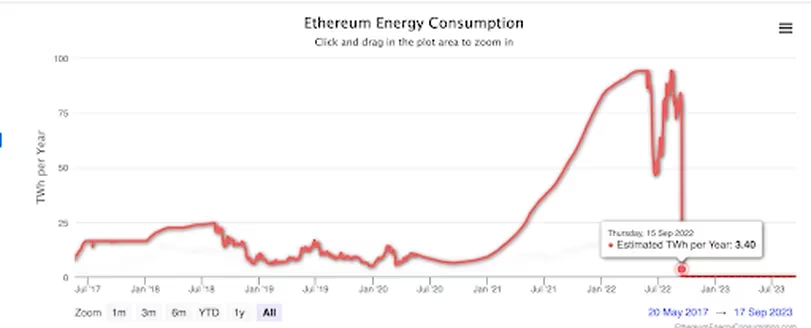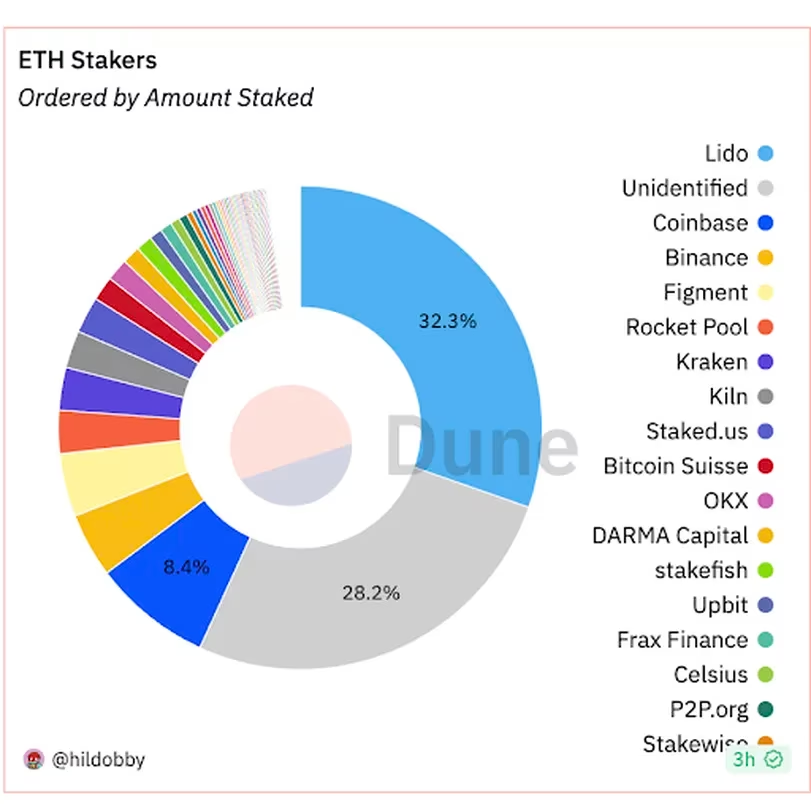Author: Margaux Nijkerk & Sam Kessler, Coindesk
Translation: Felix, LianGuaiNews
Ethereum merger has been over a year now, and this transformation, known as “staking,” introduces a new method of adding and approving transaction blocks to the blockchain.
In the PoW (Proof of Work) mode, miners compete to add blocks by solving cryptographic puzzles. Now, in the PoS (Proof of Stake) mode, Ethereum validators stake 32 ETH (about $50,000) on the network and are randomly selected to add blocks. In both modes, miners and validators receive ETH rewards if their blocks are added to the blockchain.
- Creating decentralized credit for DeFi, is the Dual-wheel driven DeCredit Summer coming?
- Actively constructing a multi-polar regulatory model for legal digital currencies under the new situation.
- Logarithm Finance Will LPDFi be the next new narrative?
Through staking, Ethereum has greatly reduced the environmental impact of the blockchain, but it still faces a series of challenges regarding centralization, censorship, and the exploitation of certain infrastructure intermediaries. Here are five key points in the Ethereum ecosystem since the merger:
Ethereum’s Energy Consumption Drops by 99.9%


The merger of Ethereum completely reforms the network’s consensus mechanism – the system that the decentralized community of network operators uses to secure the network and process transactions. The old “Proof of Work” mode used a power-hungry “mining” system to operate, where network operators essentially competed to process blocks (and receive rewards) by consuming computational power.
The transition from proof of work to staking is expected to significantly reduce Ethereum’s energy consumption – completely eliminating the energy-intensive system previously used to generate blocks and protect users.
Ethereum’s energy consumption prior to the merger was roughly equivalent to that of a small country, and its energy usage statistics were a major focus of early critics of NFTs and DeFi. According to the Cambridge Bitcoin Electricity Consumption Index, Bitcoin still uses the PoW mode to power its network, consuming energy comparable to that of Singapore.
A year after the merger, Ethereum’s new emissions have sharply decreased. The Ethereum’s new Proof of Stake system reduces energy consumption by 99.9% compared to the old mining system. Regardless of whether other aspects of this upgrade have been successful or not, Ethereum is no longer harmful to the environment.
Staking Allocation Raises Centralization Concerns

In addition to criticism for its high energy costs, Ethereum’s old consensus model was also criticized for centralizing power in the hands of a small number of mining organizations with the funds, specialized hardware, and knowledge to build large-scale mining facilities. Prior to the merger, only three mining pools dominated most of Ethereum’s computing power – an indicator of the collective computing power of all miners.
As Ethereum transitions to PoS, the Ethereum network has abandoned mining and instead supports staking. This eliminates the hardware requirements and computational costs of PoW, partly to encourage more people to participate in network operation.
However, even after a year of consolidation, centralization remains one of the biggest challenges facing Ethereum. In order to stake on Ethereum, validators need to lock up 32 ETH, approximately $50,000, in the network. These funds can earn stable interest, but if validators make mistakes or engage in dishonest behavior, these funds may be revoked. Setting up validator nodes for staking on the network can also be a complex task, which means improper setup could result in economic penalties.
Due to the cost and technical barriers to setting up nodes, intermediary services have emerged – companies like Coinbase and decentralized collectives like Lido – which allow users to pool their ETH together to create the required 32 ETH for a node. These intermediaries take on the majority of the heavy lifting: they take ETH from users, stake it on their behalf, and extract a portion of the rewards earned from operating validators.
Even before the consolidation, some anti-PoS individuals were concerned that staking could increase the level of centralization in Ethereum – meaning a small portion (or even a single entity) of these intermediaries could have disproportionate control over which blocks are added to the network.
This scenario seems to be playing out. Currently, the largest staking provider is the decentralized staking pool Lido. Lido currently holds 32.3% of the total staked ETH, causing concerns among crypto enthusiasts about centralization as it approaches the 33% threshold, with developers warning that surpassing this level could pose security issues.
MEV and Censorship


After the Ethereum merge, validators gained significant extra profits through a concept called Maximum Extractable Value (MEV). Validators and builders can charge fees to users by strategically inserting or reordering transactions before adding them to the network.
When MEV unexpectedly becomes a carrier of centralization and censorship on the network, third-party interventions attempt to address the issue.
Ethereum research and development company Flashbots invented MEV-boost, software that validators can run to reduce the negative effects of MEV. However, Flashbots’ solution to the MEV problem is controversial. While some believe MEV should be completely eradicated, Flashbots’ introduction of MEV-boost has sparked new concerns about centralization.
Currently, around 90% of blocks on Ethereum are processed using MEV-Boost, which optimizes how transactions are organized into blocks to maximize profits for validators.
The popularization of MEV-boost has become a focus of debate in the network. As mentioned earlier, MEV is seen by some as unfair charges to users. The core role of Flashbots in the Ethereum MEV market has been criticized: most of the blocks built with Flashbots software are either “relayed” or delivered to validators through Flashbots itself.
This centralization is seen by some as a potential censorship medium: when the US Treasury Department approves certain Ethereum addresses related to Tornado Cash, Flashbots stops adding these transactions to blocks sent to validators. This move has sparked opposition from Ethereum builders, who believe that the infrastructure level occupied by Flashbots should be completely neutral and should not make the entire network resemble centralized payment processors like Visa.
Since the merge, the Ethereum community has been working to reduce censorship by configuring MEV-Boost to use non-Flashbots relays. Currently, 17.3% of blocks rely on Flashbots relays to extract MEV, reducing the censorship rate to 35%, which is a huge reversal compared to the peak of 78% in November 2022.
Liquidity staking tokens have taken over the ETH market

After the merge, liquidity staking has emerged in the Ethereum ecosystem.
Anyone can participate in Ethereum’s security system and earn rewards by staking ETH tokens, which involves locking ETH tokens to earn stable interest. However, there is a problem: once tokens are staked, they cannot be bought, sold, or used in DeFi (e.g., as collateral for loans), which reduces the appeal to investors who want to maximize their returns on investment.
Third-party liquidity staking services provide an alternative to traditional staking. Users who stake through services like Lido can receive a derivative ETH token representing their staked assets: liquidity staking tokens, abbreviated as “LST”.
LST can earn interest just like ETH staked in the traditional way, but the difference is that LST can be traded. This is an attractive investment for DeFi traders who want to participate in ETH staking. An additional benefit is that LST bears the staking risk without the need for users to stake 32 ETH.
Before the Shapella upgrade in April 2023, stakers were unable to withdraw their staked ETH, so users initially turned to liquidity staking to earn staking rewards without the unknown risk of the lock-up period. Once staked ETH can be withdrawn – although it eliminates a major risk of Ethereum – some people believed that the liquidity staking market might shrink and instead support traditional staking. But that’s not the case.
Currently, the liquidity staking market is worth nearly $20 billion and is growing rapidly. This is mainly due to the ubiquity of LST in DeFi and its easier accessibility compared to traditional staking. Lido’s stETH token has the largest share in the LST market, accounting for approximately 72.24%.
ETH Net Supply Decreases


There have been some changes in the tokenomics of ETH.
The most notable is that this upgrade has resulted in ETH experiencing “deflation” for the first time, which means that the total supply of ETH is decreasing rather than increasing. The circulating supply of ETH has decreased by 0.24% compared to a year ago. The decrease in supply is partly due to a network upgrade called EIP-1559, which happened about a year before the merge. After the EIP-1559 upgrade was implemented, some ETH started to be “burned” in every transaction on the network. However, the occurrence of net deflation in ETH is further reduced after the Ethereum merge, which further cuts the issuance speed of new ETH.
As the supply of ETH grows over the years, some investors are concerned that the ETH they hold will depreciate over time. Some investors hope that deflation will help make ETH more valuable. However, it is still difficult to say whether this has happened so far. In the months since the Ethereum merge, the price of Ethereum has not changed much. In comparison to deflation, the short-term impact of macroeconomic factors may be more significant than the impact of changes in supply.
Like what you're reading? Subscribe to our top stories.
We will continue to update Gambling Chain; if you have any questions or suggestions, please contact us!